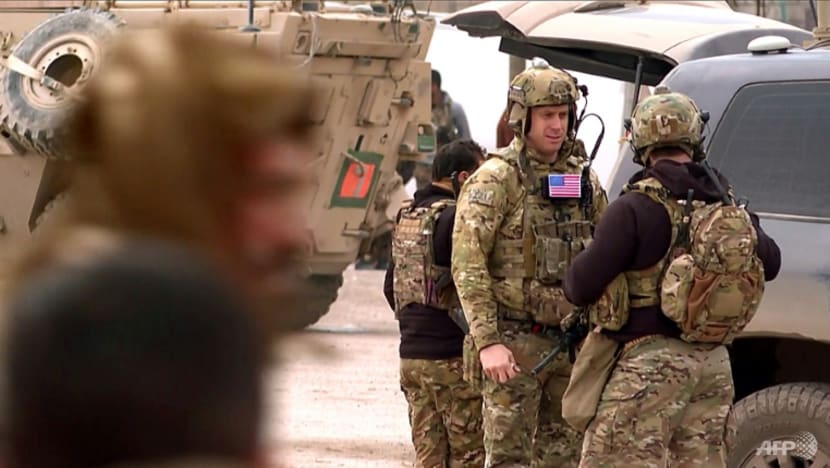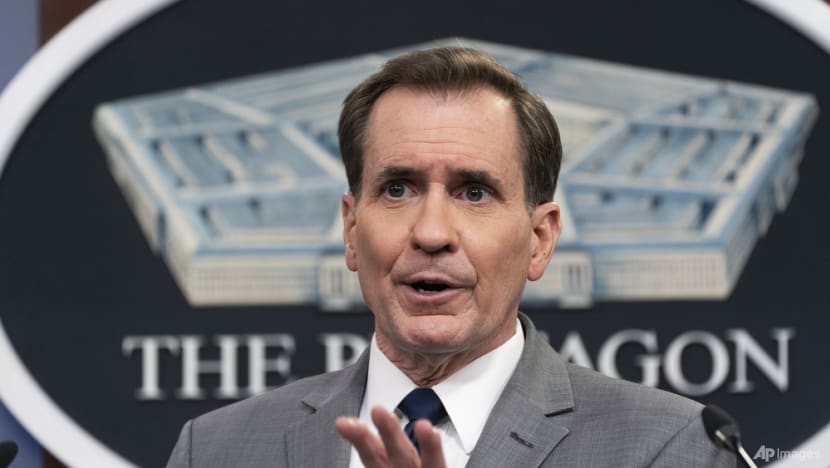Commentary: Ukraine crisis could reverse decades of decline in US military presence in Europe
Without the threat of the Soviet Union, public opposition to foreign deployments in Europe has increased in the post-Cold War era, say US professors.

US troops are seen on the ground near the prison in the Kurdish-controlled Syrian city of Hasakeh where Islamic State group fighters are holed up (Photo: AFP/Gihad DARWISH)
BOISE, Idaho: Up to 8,500 US troops could soon be heading to Eastern Europe – bolstering an American military presence in the continent that has been in decline since the end of the Cold War.
News of the possible deployment by the Pentagon comes as Russia and the United States continue to manoeuvre in the face of an escalating crisis in Ukraine.
Understanding the changing US military commitment to European countries helps us understand what is at stake in Europe and US credibility in the region.
President Joe Biden signalled during a press conference on Jan 19 that the US would increase its troop presence in the North Atlantic Treaty Organization (NATO) countries in Eastern Europe if Russia invades Ukraine as it seems poised to do.
Just days later, he directed Secretary of Defense Lloyd Austin to place thousands of US troops on heightened alert for deployment to Eastern Europe.
The decision was framed by the Pentagon as the US carrying on with its obligations to protect the security of NATO allies.
While Biden acknowledges that Ukraine is not a member of NATO, he emphasised that neighbouring countries Poland and Romania are, and that the US has an obligation to protect them.
A large troop deployment – potentially to bolster NATO’s existing presence in those two countries – would meet that obligation.
The US and Russia have historically been cautious in not placing troops in places that would be considered a provocation. They generally avoid each other’s sphere of influence, even when responding to the other’s deployments.
Yet the NATO allies in Eastern Europe, many of which were once Soviet satellite states, provide a grey area that both the US and Russia may view as within their own sphere of influence.
NATO EXPANDED IN THE POST-COLD WAR ERA
Since the end of World War II, the United States has deployed hundreds of thousands of service members to Europe.
These deployments were vital in not only stabilising Western Europe following the war, but also in exerting US influence in the postwar environment.
Interactions between the US and European countries during this period involved the creation of a series of institutions to help structure the rules and norms of international relations.
These organisations have persisted in part because the United States provides security commitments to countries that accept and promote them.
NATO, a military alliance established in 1949 as a bulwark to Soviet expansionism, was central to these efforts.
At its height in the late 1950s, US presence in Europe consisted of about 430,000 troops, stationed in places like West Germany and the UK.
After the end of the Cold War, NATO sought to redefine its mission from one that checked Russian aggression to European stability more generally.
This change in mission came with the expansion of NATO membership to Central and Eastern European countries, such as Hungary and Poland, and the Baltic States of Estonia, Latvia and Lithuania.
With NATO membership came new deployments of US service members to these countries.
NATO has also sought to expand its relationships with non-member states throughout Eastern and Central Europe through the Membership Action Plan, which provides advice and assistance to countries wishing to join NATO.
This eastward push came with objections from Russia in the 1990s, which has long worried about the security of its western borders with Europe.
Russia’s concern about NATO expanding to its border continues today, as seen in President Vladimir Putin’s demand that NATO forces pull back from deploying in former Soviet states.
A SHIFT AWAY FROM EUROPE?
If the US follows through with beefing up its military presence in Eastern Europe, it would reverse a trend that has seen American troop numbers dwindle in Europe significantly since the end of the Cold War.
The Sep 11, 2001, attacks in particular marked a dramatic shift in where the US focused its troop deployments and security concerns.
The beginning of the war in Afghanistan in 2001 and the 2003 invasion of Iraq brought massive changes in the United States’ military position globally as it shifted focus to Central Asia and the Middle East.
In 1989, the United States had 248,621 permanent troops stationed in West Germany, 27,639 in the United Kingdom, 15,706 in Italy and 3,382 in Greece.
By September 2021, US troop numbers had fallen to 35,457 in Germany, 9,563 in the United Kingdom, 12,434 in Italy and 429 in Greece.

While the size of US deployments to Europe have declined dramatically since their Cold War heights, they are still very large relative to most other US deployments.
Without the threat of the Soviet Union, though, public opposition to foreign deployments has also increased in the post-Cold War era.
However, rising tensions with Russia have in the recent past prompted US presidents to dedicate additional military aid and deployments to Poland and the Baltic States.
This trend looks set to continue if the Pentagon does indeed deploy thousands of troops to Eastern Europe in the face of a threatened invasion by Russia of Ukraine.
Michael A Allen, Carla Martinez Machain and Michael E Flynn are Professors of Political Science at Boise State University and Kansas State University. This commentary first appeared on The Conversation.















